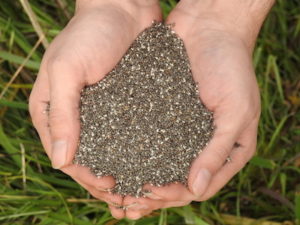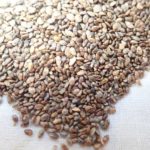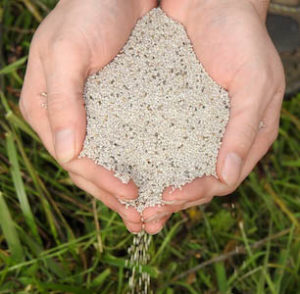
Chia seed, that powerful little bundle originating from the American Southwest and Mesoamerica, is truly unrivalled in terms of its nutritional value and health benefits. Chia is the most concentrated source of alpha-linoleic acid (Omega-3 fatty acids) in the plant kindom, making it an ideal food for those suffering from inflammation of any sort, including maladies of the nerves, eyes or brain. Use of chia helps regulate the metabolism of sugar and cholesterol. Chia also addresses maladies of the intestines and digestion. Loaded with soluble fiber, the seed absorbs toxins, bulks the stools, slows transit time and contributes to a feeling of satiation–very helpful to weight-watchers! Whip a tablespoonfull of chia seeds into a glass of water and within a few hours a beautiful suspension of polysaccharide-rich mucilage will be attained. Chia seed contains all 8 essential amino acids–up to 23% protein. This makes a sustaining food, an excellent choice for daily diet. The seeds can be soaked and slurped as a thick drink, mixed into fruit juices, or ground into a powder and mixed with the morning cereal, also incorporated into soups or baked goods. My wife and I particularly enjoy a desert dish we make by whipping a tablespoon of chia seeds into coconut milk with a dash of stevia and vanilla which we refrigerate overnight. The next morning, we have a rich pudding that can be eaten as-is or used as a topping for fresh fruit. Indeed, a supply of chia seeds should always be held in kitchen or root cellar in case of emergency, as pound-for pound, there is no more concentrated and lively a food. Valued since antiquity as a superfood, chia was cultivated, consumed and traded by peoples of the Olmec, Mayan and Aztec civilizations, from 3500 BC all the way up to the 1400’s. Today we still experience the benefits of this potent little seed which is long-lived in storage, containing enough antioxidants to maintain freshness for years–even after grinding.
The Mexican Chia (Salvia hispanica) plant is a fast-growing subtropical to tropical annual that matures in 120 to 180 days from seeding. The leaves of the plant are smooth and wholesome smelling, and the flowers are generally blue, sometimes purple or white. Chia is rarely bothered by pests. There is a wide degree of variation depending on ecotype and cultivar. White chia seed and black chia seed are produced by different strains of the plant, being pretty much identical in all respects except for color, used interchangeably for food and medicine. The plant can be grown as a direct-seeded annual in zones 9 to 12, and if started early in the greenhouse may be grown as a summer annual in Zones 6 to 8, as well. Chia seeds should be surface-sown, and typical to any seed that develpps its own mucilage on wetting, germination is very rapid. 3-day germination of our select chia seed in a flat in the greenhouse is typical. The plant itself prefers dryish soils and a full sun exposure. A spacing of 3 feet will encourage a tall plant (to 6 feet) that makes plenty of seeding racemes and has a good chance of maturing its seed before winter hits. Close spacing will produce shorter plants and retard seed development. The flowering and seed maturation of Mexican chia is day-length dependent, requiring short days to flower. Therefore the plants tend to be vegetative during the long days of summer and must hurry to make seeds before fall. This is why growing large tracts of this kind of chia can be more reliably accomplished in the tropics and especially at medium elevation sites in the tropics or subtropics, which will tend to result in seed of the highest quality. Several cultivars of chia have been documented, and new ones developed. Each carries advantages for different cultivation conditions–zone, elevation, water supply, etc.
Desert chia (Salvia columbariae), also known as golden chia, is a very quick annual and is a good choice for gardeners in the American Southwest. Simply strew the seed during the winter months and harvest when the seedheads ripen spring to early summer. Gardeners in the temperate north can grow desert chia, too–that is if they can give the plant enough sun, heat and dry soil. It is easy to pull off a quick spring seedcrop of desert chia using pots in the greenhouse. I’ve seen it go to seed in as little as 60 days.
Mexican chia (Salvia hispanica) on the other hand takes much longer to mature. Growers of Mexican chia in the temperate zones will want to test a small plot and enjoy the green beauty of the plants, then hurry to harvest whatever seed may show prior to frost. As a test, rubbing the seed head between the hands should yield a few seeds that can be checked for ripeness. Brown seed is unripe, tightly-formed black or white seed is ripe. Once they are mature, the seedheads should be cut and dried on paper, then ground through a screen or threshed to yield their seeds, which can then be purified by the use of graduated stainless steel screens and wind separation. Although growing your own chia from seed is fun and a vote for garden-to-table sustainability, organic chia seed in bulk is actually inexpensive for what it contributes, and in my larder at least we never lack for a good bag of organic chia–it is part of what makes us healthy and strong.





Nice. Need to try to grow some – we’re all about self-sustainability on this ranch, and we’re Mediterranean climate in N Calif with hot, dry summers (and irrigation) and frequently more than 180 days of frost-free time.